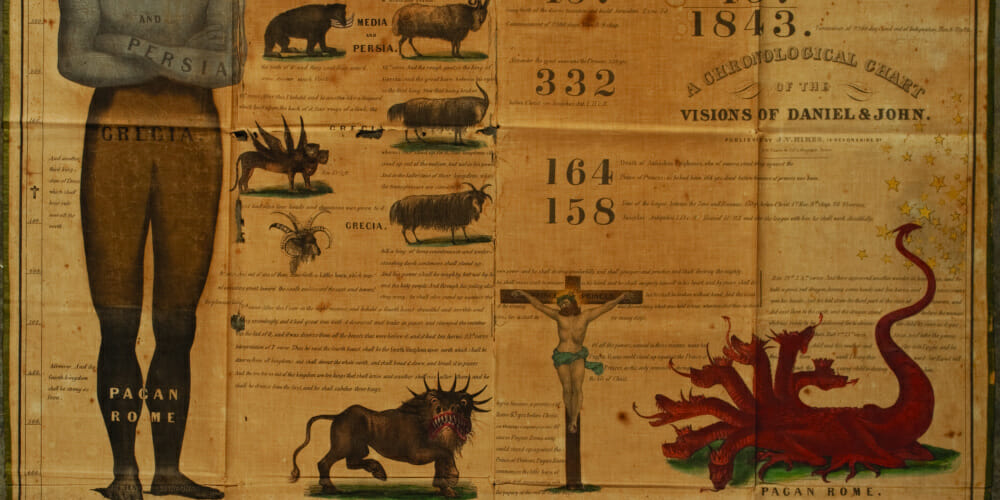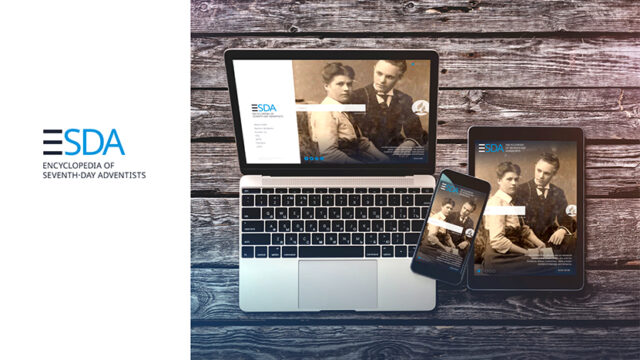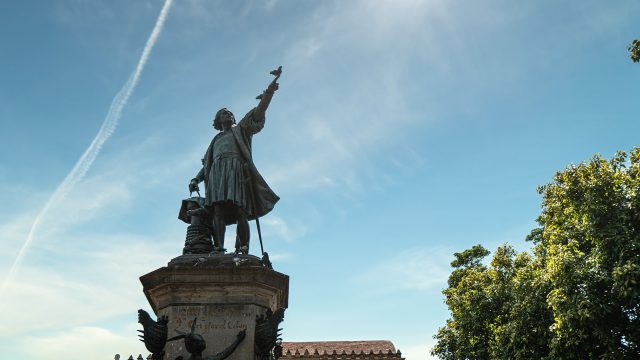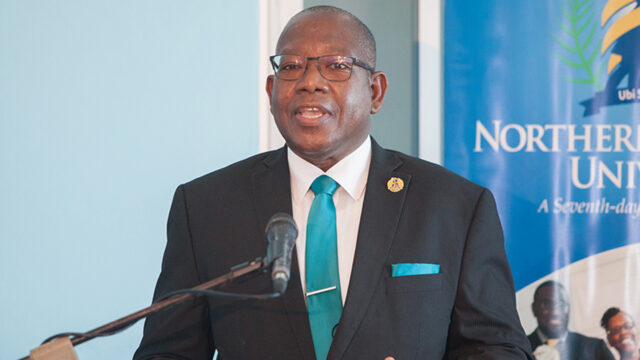Fitch was firm. No longer was he afraid of ridicule or censure.

A storm was brewing in Buffalo, New York. Located on the northeast side of Lake Erie, the city had never felt such a strong, driving wind as during those early October days of 1844.1
But in spite of the inclement weather, crowds came to hear Charles Fitch explain why Jesus was coming very soon.
With the aid of a prophetic chart he had designed a few years earlier, Fitch guided listeners through the prophecies of Daniel and Revelation, showing them, one beast at a time, how prophecy had been accurately fulfilled.
Fitch, a well-educated preacher, had worked with famed evangelist Charles G. Finney. He had also pastored several churches in New England, including the well-to-do Marlboro Street Congregational Church in Boston.
Known as an abolitionist, Fitch wrote a pamphlet in 1837 titled Slaveholding Weighed in the Balance of Truth, and Its Comparative Guilt Illustrated. Attempting to describe the horrors of slavery, Fitch confessed, “The evil has a magnitude which my powers cannot describe; and the guilt a blackness which can never be painted, except by a pencil dipped in the midnight of the bottomless pit.”2
An Overwhelming Interest
While Fitch was in Boston, someone gave him a copy of William Miller’s lectures entitled Evidence From Scripture and History of the Second Coming of Christ.3 Fitch eagerly studied the lectures, stating in a letter to Miller his “overwhelming interest, such as I never felt in any other book except the Bible.”4
At his church Fitch preached on the Second Coming, creating deep interest among his parishioners. Three days later he presented the topic to colleagues at the ministerial association in Boston. Expecting a warm reception, Fitch brought 12 copies of Miller’s Evidence for distribution.
Unfortunately, “the association’s reaction was so negative and accompanied with so much “searing ridicule and contempt that for a time [Fitch] lost confidence in [the Advent message], and lapsed into his former views.”5
Views of Sanctification
Although Fitch bowed to peer pressure, he continued diligently studying his Bible. In 1839, while pastoring the Free Presbyterian Church in Newark, New Jersey, Fitch wrote Views of Sanctification6—providing his statement of faith and stressing sanctification by divine grace through Scripture.
Fitch’s book led some to label him a “perfectionist.” A committee was appointed to “counsel” Fitch on his views, resulting in a Resolution of Censure, declaring his views to be a “dangerous error” and requiring him to stop preaching on this topic.
Refuting the charges, Fitch wrote: “Can I tell the people of God that they have no Saviour from sin during their whole lives; that live as long as they may, and labor as hard as they may to find out the path of life, and pray as fervently as they may, and trust in their Saviour for the fulfillment of the promises as fully as they may, they are doomed hopelessly to sin more or less against the Redeemer they love, even to their dying hour; that all their cries and struggles for help are vain, and that they must be, to some extent rebels against the heart of infinite love, until the grim monster death appears for their deliverance?”7
Fitch was firm. No longer was he afraid of ridicule or censure. Believing he was called to preach the “blessed doctrine of sanctification by faith in Christ,”8 Fitch soon withdrew from the Newark Presbytery.
The Advent Hope and Sanctification
In 1841 Josiah Litch, a physician and Millerite preacher, urged Fitch to reconsider the Advent truth, stating: “What you need is the doctrine of the second advent to put with the doctrine of holiness.”9
After further study and prayer Fitch fully embraced the message of Christ’s soon return. He became one of the most respected and beloved Millerite preachers, known for his compassion for people, his earnestness for their salvation, and his depth in Bible study.
By 1843 Fitch realized from his study of Revelation 14 and 18 that the Babylon referred to as “fallen” included not just the Roman Catholic Church but apostate Protestant churches as well. He preached a powerful sermon, “Come Out of Her, My People,”10 and soon published it. Thousands responded, leaving the churches of their childhood and joining the Bible-based people who were looking for Christ’s soon return.
Baptism in Lake Erie
As Charles Fitch preached during that blustery day in Buffalo, New York, hearts were convicted that this man taught Bible truth. New believers requested baptism and were baptized in Lake Erie.
The wind was blowing as Fitch headed home in his wet clothes following the baptism. He had not gone far, however, when he met another group desiring baptism. Fitch returned to the lake and baptized them. Again heading home, Fitch was met by a third group that pleaded to be baptized. Although chilled by the wind and his wet clothes, Fitch went back to the lake and baptized them.11
In spite of feeling ill, Fitch rode several miles the next day to keep an appointment. Sadly, he contracted pneumonia and died on October 14, 1844, at the age of 39.12
Although he did not live long enough to be part of the “little flock” that became Seventh-day Adventists, Charles Fitch exhibited the same character qualities and spiritual fortitude, and preached much the same message, as the Adventist pioneers who continued searching the Scriptures, sharing light with others, and eventually establishing the Seventh-day Adventist Church. In fact, Charles Fitch is one of only a handful mentioned by name whom Ellen White saw would be in heaven.13
Fable or Fact?
Do we still believe today the Bible message that led honest souls to “come out of Babylon” and become a part of the remnant “who keep the commandments of God and have the testimony of Jesus Christ” (Rev. 12:17)? Do we still believe the “sure word of prophecy” (2 Peter 1:19, KJV)? Are the prophecies of Daniel and Revelation still relevant today, or relics of the past?
Do we embrace the message of Christ’s ministry in the heavenly sanctuary? Do we still believe that God is not only gracious enough to justify us, but is powerful enough to sanctify us? Are we still eagerly looking forward to and “hastening . . . the day” (2 Peter 3:12) of Christ’s second coming? Is God’s truth, as revealed in the Bible, still more important than the opinions of others?
It is my prayer that we each recognize we have not followed “cunningly devised fables when we made known to you the power and coming of our Lord Jesus Christ” (2 Peter 1:16), but will “hold fast the confession of our hope without wavering, for He who promised is faithful” (Heb. 10:23).
Maranatha! Jesus is coming soon!
1 “The ‘October Surprise’ of 1844”, www.buffalohistorygazette.net/2010/09/the-lake-erie-seiche-disaster-of-1844.html.
2 Charles Fitch, Slaveholding Weighed in the Balance of Truth, and Its Comparative Guilt Illustrated (Boston: Isaac Knapp, 1837), p. 3, https://ia802502.us.archive.org/28/items/ASPC0001888700/ASPC0001888700.pdf.
3 Available at https://m.egwwritings.org/en/book/1321.13#13.
4 Letter from Charles Fitch to William Miller, March 5, 1838, www.earlysda.com/miller/william-miller-biography-5.html.
5 LeRoy Edwin Froom, The Prophetic Faith of Our Fathers (Washington, D.C.: Review and Herald Pub. Assn., 1954, 1982), vol. 4, p. 534, m.egwwritings.org/en/book/1583.3109.
6 Available at m.egwwritings.org/en/book/1259.7#7.
7 Charles Fitch, “Letter to the Presbytery of Newark” (1840), p. 19, m.egwwritings.org/en/book/1014.95#95.
8 Charles Fitch, “Reasons for Withdrawing From the Newark Presbytery,” 1845, p. 1, play.google.com/store/books/details/Reasons_for_withdrawing_from_the_Newark_Presbytery?id=HocxBHexWocC&hl=en.
9 In Froom, p. 536.
10 Charles Fitch, “Come Out of Her My People” (Rochester, N.Y.: J. V. Himes, 1843), m.egwwritings.org/en/book/2006.2#0.
11 See Froom, p. 545.
12 Ibid.
13 Ellen G. White, Early Writings (Washington, D.C.: Review and Herald Pub. Assn., 1882, 1945), p. 17.
Ted N. C. Wilson is president of the worldwide Seventh-day Adventist Church. Additional articles and commentaries are available from the president’s office on Twitter: @pastortedwilson and on Facebook: @Pastor Ted Wilson.








